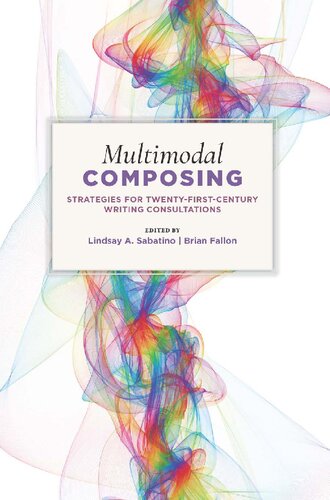

Most ebook files are in PDF format, so you can easily read them using various software such as Foxit Reader or directly on the Google Chrome browser.
Some ebook files are released by publishers in other formats such as .awz, .mobi, .epub, .fb2, etc. You may need to install specific software to read these formats on mobile/PC, such as Calibre.
Please read the tutorial at this link. https://ebooknice.com/page/post?id=faq
We offer FREE conversion to the popular formats you request; however, this may take some time. Therefore, right after payment, please email us, and we will try to provide the service as quickly as possible.
For some exceptional file formats or broken links (if any), please refrain from opening any disputes. Instead, email us first, and we will try to assist within a maximum of 6 hours.
EbookNice Team

Status:
Available5.0
35 reviews
ISBN-10 : 1607328453
ISBN-13 : 9781607328452
Author: Lindsay A. Sabatino, Brian Fallon
Multimodal Composing provides strategies for writing center directors and consultants working with writers whose texts are visual, technological, creative, and performative—texts they may be unaccustomed to reading, producing, or tutoring. This book is a focused conversation on how rhetorical, design, and multimodal principles inform consultation strategies, especially when working with genres that are less familiar or traditional. Multimodal Composing explores the relationship between rhetorical choices, design thinking, accessibility, and technological awareness in the writing center. Each chapter deepens consultants’ understanding of multimodal composing by introducing them to important features and practices in a variety of multimodal texts. The chapters’ activities provide consultants with an experience that familiarizes them with design thinking and multimodal projects, and a companion website (www.multimodalwritingcenter.org) offers access to additional resources that are difficult to reproduce in print (and includes updated links to resources and tools). Multimodal projects are becoming the norm across disciplines, and writers expect consultants to have a working knowledge of how to answer their questions. Multimodal Composing introduces consultants to key elements in design, technology, audio, and visual media and explains how these elements relate to the rhetorical and expressive nature of written, visual, and spoken communication.
1. Introduction: Design Theory and Multimodal Consulting
2. Storyboard(ing): Multimodal Tool and Artifact
3. Artist and Design Statements: When Text and Image Make Meaning Together
4. Brochures: Helping Students Make Good Design Decisions
5. Academic Research Posters: Thinking Like a Designer
6. Prezi and PowerPoints Designed to Engage: Getting the Most Out of Quick-and-Dirty Pathos
7. Infographics: A Powerful Combination of Word, Image, and Data
8. ePortfolios: Collect, Select, Reflect
9. Web-Design Tutoring: Responding as a User
10. Podcasts: Sound Strategies for Sonic Literacy
11. Multimodal Video Projects: Video—Doing by Example
12. Public Service Announcements (PSAs): Focused Messages for Specific Audiences
13. Professional Identity and Social Media: Consulting Personal Branding Projects
14. Copyright and Citations for Multimedia Sources
an introduction to and strategies for multimodal composing
why is multimodal composing important
what does multimodal composing involve the use of
digital multimodal composing dmc
an introduction to and strategies for multimodal composing summary
Tags: Multimodal Composing, Strategies, Twenty First Century, Consultations, Lindsay Sabatino, Brian Fallon